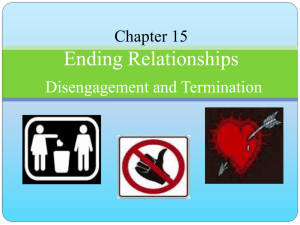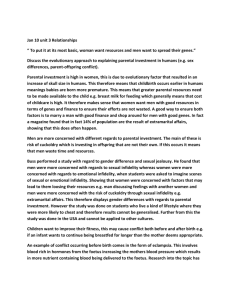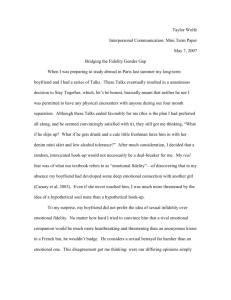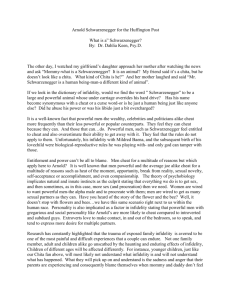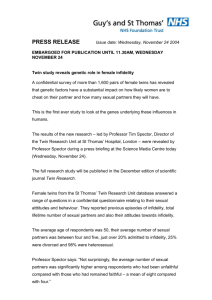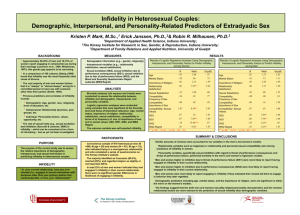human development research paper
advertisement
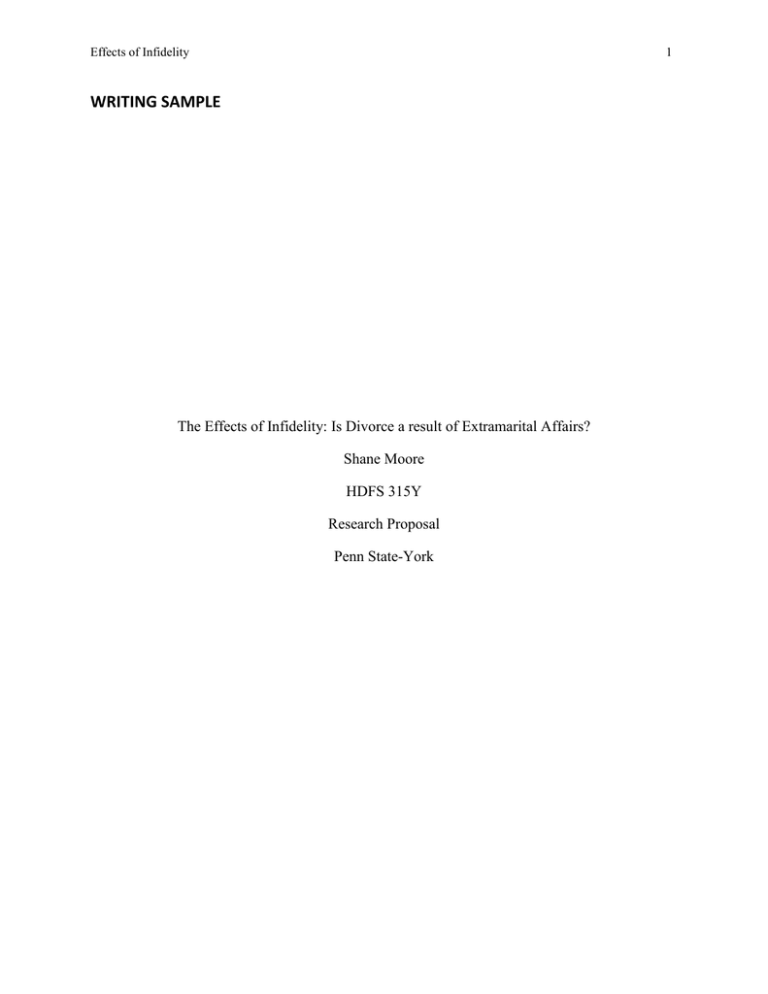
Effects of Infidelity 1 WRITING SAMPLE The Effects of Infidelity: Is Divorce a result of Extramarital Affairs? Shane Moore HDFS 315Y Research Proposal Penn State-York Effects of Infidelity 2 Abstract This paper looks at infidelity and whether infidelity leads to divorce and under what circumstances. It discusses research that focuses on infidelity and the causes of infidelity. The references that were used for this paper evaluates personal views and thoughts regarding infidelity, how to avoid infidelity if possible and what leads up to infidelity which is the 3rd leading cause of divorce. Effects of Infidelity Effects of Infidelity 3 Roughly 6000 couples daily are joined into holy matrimony. Out of the 6000 that are married each day at least half of the couples end up in divorce proceedings. There are many reasons why a couple ends up in divorce proceedings. Lack of communication, irreconcilable differences, money and or infidelity is just the tip of the iceberg. The two biggest reasons for divorce are money and infidelity. The most damaging is infidelity. Depending on who is being asked, infidelity is the betrayal of all betrayals. Infidelity breaks the, breaks the trust and breaks the bond that two people have developed. Is infidelity the cause of divorce or is it just a symptom of what is actually wrong with the marriage leading into divorce. What is Marriage? Amaato, and Previti (2003) suggest that marriage means something different to the couples entering marriage but the general meaning is the union of two people coming together as one and every aspect of their lives become one. Marriage can be viewed from multiple perspectives depending on the individual, but should be comprised of love, respect, trust, communication and understanding. What is Infidelity? Simply put, infidelity is a breach of contract, the marital contract. Marriage vows mean something different to each and every couple. Depending on the couple or individual the ultimate meaning of marriage is trust, faithfulness, commitment and loving each other until death do you part. Infidelity is when one of these, if not all has been broken or neglected and can cause marital distress. Effects of Infidelity 4 Forms of Infidelity Committing adultery is only one form of infidelity. There is physical, mental, and emotional infidelity. Physical infidelity is one or both parties have sexual relationships outside the marriage. This type of infidelity is the most difficult to resolve within the marriage. Mental infidelity is not letting go of the past so the future and the marriage are the main priority. Emotional infidelity is when one spends time with another person, giving attention to another outside of the marriage but not becoming physical. There is a new form of infidelity; cyber infidelity which is seeing someone over the internet. Sexting is also a form of infidelity. Depending on the individual all are just as damaging as the next. Marriage and Leading Causes of Infidelity According to Blow and Hartnett (2005) most couples face the question of infidelity at some point in their marriage or committed relationship. How one views infidelity depends on one's culture, attitudes towards infidelity, values that have been taught from a child to adulthood, previous relationships and one's own personal fears. Most couples before marriage do not have the conversation about infidelity out of fear for what they may or may not hear. This is due to lack of communication from the beginning. According to Doherty(2013) out of the 6000 couples married daily at least 40%- 50% will end in divorce due to lack of communication. When couples do not have good premarital communication skills more than likely these skills will not be in the marriage. According to Zur (2013) it was once thought infidelity was composed only of men and suggest that this is no longer true and just as many women commit adultery as men, but for different reasons. Zur (2013) also suggest that infidelity is not the cause of divorce and that once infidelity has been committed that it can be worked through. More women than men Effects of Infidelity 5 are more likely to commit adultery as a last resort and some studies suggest that women take infidelity more seriously than men. Blow, Hartnett (2005) suggest that the causes of infidelity are hard to pin point because of the many different variations of infidelity. Blow, Hartnett (2013) also suggest that there are many reasons why infidelity exists in a marriage. The lack of communication, incompatibility, conflict, growing in different directions, mental illness, work, and forgetting why they fell in love in the first place; assuming this is the reason the marriage took place to begin with. In most cases infidelity does not just happen; it is a combination of things that lead to infidelity. There is no cause for infidelity is a choice. Markman, Rhoades, Stanley, Ragan, and Whitton (2007) suggest that non communication is the biggest factor and that the negatives in the marriage outweigh the positives in the marriage. They are not indicating that there are more negatives than positives, but simply that the focus is on the negatives more than the positives leading to a stressed marriage. According to Balderrama-Durbin and Rhoades(2010), 22%-25% of men commit some form of infidelity compared to 11%-15% of women and out of this range of men and women the reason for the infidelity was problems within the marriage. Unhappy couples are likely to engage in the blaming game such as criticism, name calling, not accepting responsibility for anything that goes wrong in the marriage and contempt for the other person. By this stage the infidelity has already taken place and the couples now enter the stage which is known as demand and withdrawal behavior where the wife usually demands change from her husband and the husband withdraws from the wife. Excellent premarital communications, trust, respect and good conflict resolution leads to a good marriage. Effects of Infidelity 6 Does infidelity lead to divorce? Infidelity is the 3rd largest reason for divorce and according to Whisman, Gordon and Chatav (2007) infidelity is the most damaging and the hardest form of betrayal to overcome and that sexual infidelity is a huge problem for most married couples and committed relationships. Personal views, individual differences and even different personalities can lead to infidelity. According to Doherty (2013) at least 10%-15% of married woman and 20%-25% of married men admit to having extra marital affairs and this nearly doubles the chance of divorce. Effects of Infidelity According to Doherty (2013) there are three stages of infidelity, suspected infidelity, confirmed infidelity, and healing and recovery. Infidelity does not have to end the marriage, but rather the underlying issues that lead to the infidelity. Doherty (2013) states that at least 63% of married couples would not forgive their spouse for infidelity, meaning the marriage would not survive. If you cannot forgive your spouse for infidelity; than a couple cannot begin to work on the issues that led to the infidelity in the first place. In order for the marriage to survive infidelity there are meaningful steps that must take place to heal the marriage. After infidelity is recognized in the relationship there are several stages that couples go through, bouts of shock, then the hurt comes and then the anger. Obsessions start to control one's mind along with fear, mistrust, hopelessness and powerlessness; these feelings are all felt by the betrayed because they have no control over anything that has taken place. The betrayer may feel a sign of relief, shamefulness, fear and anger, anger over the end of and problems within the marriage that they cannot get passed, while others want to try whatever it takes to correct and heal the marriage. Doherty (2013) suggests that the best way to deal with infidelity is to internalize it, meaning Effects of Infidelity 7 accept it, process it, forgive and move on. But, that is easier said than done. The couples are then left with seeking professional help and because seeking professional help is the best option. Every thought, every communication and every feeling needs to be positive and constructive at this point. Learning what caused the problems in the marriage that lead to the infidelity is the best and is the starting point. Most betrayed do not want to hear that they had some fault, not in the infidelity but in the breakdown of the marriage. In order to stop this cycle and the break down in the marriage Raithwaite, Lambert, Finchman and Pasley (2010) suggest that relationship education is in order and designed to help couples become productive, positive and stable within the marriage and as individuals. Blow,Hartnett (2005) suggest that during therapy different avenues should be explored; ones social economic status, personal and religious views, and educational background. Studying all these different factors helps the therapist devise a plan of action for the couples. Blow, Hartnett (2005) also suggest that infidelity is preventable in most cases if the issues can be addressed premarital or during the early stages when conflicts can not be resolved. Conclusion Infidelity has been in existence since biblical times and in the last 50 years or so has become more prevalent. But infidelity is not actually what causes marriages to end. There are most always under lying factors that leads up to infidelity. Infidelity is still a conscious act on the part of the betrayer and can almost always be avoided. The betrayed never causes the act of infidelity rather lack of communication, personal differences, lack of respect and lack of trust, insecurities, and differences of opinions leads to infidelity. References Effects of Infidelity 8 Allen, E. S., & Atkins, D. C. (2012). The association of divorce and extramarital sex in a representative u.s. sample. Journal of Family Issues, 33(1477), 1478-1490. doi: 10.1177/0192513X12439692 Amato, P. R. and Hohmann-Marriott, B. (2007). A Comparison of High- and Low-Distress Marriages That End in Divorce. Journal of Marriage and Family, 69(3): 621–638. doi: 10.1111/j.1741-3737.2007.00396.x Balderrama-Durbin, C., Allen, E. S., & Rhoades, G. K. (2012). Demand and withdraw behaviors in couples with a history of infidelity. Journal of Family Psychology, 26(1), 11-17. doi: http://dx.doi.org/10.1037/a0026756 Blow, A. J., & Hartnett, K. (2005). Infidelity in committed relationships ii: A substantive review. Journal of Marital and Family Therapy, 31(2), 217-33. Retrieved from http://search.proquest.com/docview/220944150?accountid=13158 Blow, A.J., Hartnett, K. (2007). INFIDELITY IN COMMITTED RELATIONSHIPS I: A METHODOLOGICAL REVIEW. Journal of Marital and Family Therapy. Volume 31, Issue 2. http://onlinelibrary.wiley.com/doi/10.1111/j.1752-0606.2005.tb01555.x/ *Braithwaite, S. R., Lambert, N. M., Fincham, F. D., & Pasley, K. (2010). Does college-based relationship education decrease extradyadic involvement in relationships? Journal of Family Psychology, 24(6), 740-745. doi: http://dx.doi.org/10.1037/a0021759 Doherty, H, W. Dr. (2013). How common is divorce and what are the reasons? http://www.divorce.usu.edu/files/uploads/Lesson3.pdf Effects of Infidelity 9 Markman, H. J., Rhoades, G. K., Stanley, S. M., Ragan, E. P., & Whitton, S. W. (2010). The premarital communication roots of marital distress and divorce: The first five years of marriage. Journal of Family Psychology, 24(3), 289-298. doi: http://dx.doi.org/10.1037/a0019481 Vogel, W., Ph.D. (2000) Culturally Competent Family Therapy. Psychiatric Services. Vol, 51, No. 9 http://journals.psychiatryonline.org/article.aspx?articleid=84949 Whisman, M. A., & Snyder, D. K. (2007). Sexual infidelity in a national survey of american women: Differences in prevalence and correlates as a function of method of assessment. Journal of Family Psychology, 21(2), 147-154. doi: http://dx.doi.org/10.1037/08933200.21.2.147 Whisman, M. A., Gordon, K. C., & Chatav, Y. (2007). Predicting sexual infidelity in a population-based sample of married individuals. Journal of Family Psychology, 21(2), 320-324. doi: http://dx.doi.org/10.1037/0893-3200.21.2.320 Zur, Ofer, Ph.D. Infidelity and Affaires: Facts, myths and what works. Zur Institute. http://www.zurinstitute.com/infidelity.html#phases

